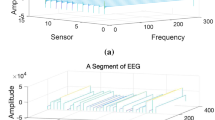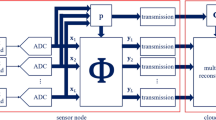Abstract
Wireless body area networks (WBANs) are increasingly used for remote healthcare surveillance in recent times, where electrocardiogram (ECG) signals are continuously acquired and transmitted to a base station or remote hospital for their storage and subsequent analysis. Multichannel ECG (MECG) is preferred over single-channel ECG as it provides more information from diagnostic point of view. One of the biggest challenges is to minimize the energy required for the WBAN network for continuous transmission of MECG data, which in turn demands for efficient data compression. Compressive sensing is an efficient signal processing tool for simultaneous compression and reconstruction of MECG data without visibly no or minimum loss of diagnostic information. In this paper, we propose an energy-efficient novel block-sparsity-based MECG compression scheme, which exploits both spatiotemporal correlation and multi-scale information of MECG data in the wavelet domain, effectively. Experimental results show that the proposed method outperforms other recently developed methods for MECG compression both qualitatively and quantitatively.







Similar content being viewed by others
References
E.J. Candes, M.B. Wakin, An introduction to compressive sampling. IEEE Signal Process. Mag. 25(2), 21–30 (2008)
E.J. Candes, J. Romberg, T. Tao, Robust uncertainty principles: exact signal reconstruction from highly incomplete frequency information. IEEE Trans. Inf. Theory 52(2), 489–509 (2006)
H. Cao, V. Leung, C. Chow, H. Chan, Enabling technologies for wireless body area networks: a survey and outlook. IEEE Commun. Mag. 47(12), 84–93 (2009)
S. Chen, D. Donoho, M. Saunders, Atomic decomposition by basis pursuit. SIAM J. Sci. Comput. 20(1), 33–61 (1998)
I. Daubechies, Ten lectures on wavelets. Society for industrial and applied mathematics (SIAM, Philadelphia, 1992)
B. Deka, S. Datta, Compressed sensing magnetic resonance image reconstruction algorithms: a convex optimization approach. Springer series on bio- and neurosystems (Springer, Singapore, 2019)
W. Deng, Y. Wotao, Z. Yin, Group sparse optimization by alternating direction method. Technical report, Rice University (2011)
S. Eftekharifar, T.Y. Rezaii, S. Beheshti, S. Daneshvar, Block sparse multi-lead ECG compression exploiting between-lead collaboration. IET Sig. Process. (2018). https://doi.org/10.1049/iet-spr.2018.5076
A.L. Goldberger, L.A. Amaral, L. Glass, J.M. Hausdorff, P.C. Ivanov, R.G. Mark, J.E. Mietus, G.B. Moody, C.K. Peng, H.E. Stanley, Physiobank, physiotoolkit, and physionet: components of a new research resource for complex physiologic signals. Circulation 101(23), E215–E220 (2000)
J. Hua, H. Zhang, J. Liu, J. Zhou, Compressive sensing of multichannel electrocardiogram signals in wireless telehealth system. J. Circuits Syst. Comput. 25, 1–21 (2016)
S. Kumar, B. Deka, S. Datta, Block-sparsity based compressed sensing for multichannel ecg reconstruction. in Deka B., Maji P., Mitra S., Bhattacharyya D., Bora P., Pal S. (eds) Pattern Recognition and Machine Intelligence. PReMI 2019. Lecture Notes in Computer Science, vol. 11942. Springer, Cham (2019)
S. Kumar, B. Deka, S. Datta, Multichannel ECG reconstruction based on joint compressed sensing for healthcare applications. in Compressive Sensing in Healthcare, (Academic Press, 2020) pp. 185–200
H. Mamaghanian, G. Ansaloni, D. Atienza, P. Vandergheynst, Power-efficient joint compressed sensing of multi-lead ECG signals. in IEEE International Conference on Acoustics, Speech and Signal Processing (ICASSP) 2014(2014), pp. 4409–4412
H. Mamaghanian, N. Khaled, D. Atienza, P. Vandergheynst, Compressed sensing for real-time energy-efficient ECG compression on wireless body sensor nodes. IEEE Trans. Biomed. Eng. 58(9), 2456–2466 (2011)
PhysioNet. www.physionet.org
L. F. Polania, R. E. Carrillo, M. Blanco-Velasco, K. E. Barner, Compressed sensing based method for ECG compression. in IEEE International Conference on Acoustics, Speech and Signal Processing (ICASSP) 2011 (2011), pp. 761–764
L.F. Polania, R.E. Carrillo, M. Blanco-Velasco, K.E. Barner, Exploiting prior knowledge in compressed sensing wireless ECG systems. IEEE J. Biomed. Health Inform. 19(2), 508–519 (2015)
A. Rakotomamonjy, Surveying and comparing simultaneous sparse approximation (or group-lasso) algorithms. Sig. Process. 91(7), 1505–1526 (2011)
R. Sameni, The open-source electrophysiological toolbox (OSET) (2012). http://www.oset.ir
A. Singh, S. Dandapat, Exploiting multi-scale signal information in joint compressed sensing recovery of multi-channel ECG signals. Biomed. Signal Process. Control 29, 53–66 (2016)
A. Singh, S. Dandapat, Weighted mixed-norm minimization based joint compressed sensing recovery of multi-channel electrocardiogram signals. Comput. Electr. Eng. 53, 203–218 (2016)
A. Singh, S. Dandapat, Block sparsity-based joint compressed sensing recovery of multi-channel ECG signals. Healthcare Technol. Lett. 4(2), 50–56 (2017)
B. Surawicz, T. Knilans, Chous Electrocardiography in Clinical Practice, 6th edn. (Elsevier, Canada, 2008)
Y. Wang, J. Wang, Z. Xu, On recovery of block-sparse signals via mixed \(l_2\)/\(l_q\) (\(0 < q < 1\)) norm minimization. EURASIP J. Adv. Signal Process. 2013(1), 1–17 (2013)
Z. Zhang, B.D. Rao, Extension of SBL algorithms for the recovery of block sparse signals with intra-block correlation. IEEE Trans. Signal Process. 61(8), 2009–2015 (2013)
Z. Zhang, T. Jung, S. Makeig, B.D. Rao, Compressed sensing for energy-efficient wireless telemonitoring of noninvasive fetal ECG via block sparse Bayesian learning. IEEE Trans. Biomed. Eng. 60(2), 300–309 (2013)
J. Zhang, Z. Gu, Z.L. Yu, Y. Li, Energy-efficient ECG compression on wireless biosensors via minimal coherence sensing and weighted \(l_1\) minimization reconstruction. IEEE J. Biomed. Health Inform. 19(2), 520–528 (2015)
J. Zhang, Z.L. Yu, Z. Gu, Y. Li, Z. Lin, Multichannel electrocardiogram reconstruction in wireless body sensor networks through weighted \(l_{1,2}\) minimization. IEEE Trans. Instrum. Meas. 67(9), 2024–2034 (2018)
Y. Zigel, A. Cohen, A. Katz, The weighted diagnostic distortion (WDD) measure for ECG signal compression. IEEE Trans. Biomed. Eng. 47(11), 1422–1430 (2000)
Acknowledgements
This research work is technically supported by Visvesvaraya PhD scheme for Electronics and Information Technology, an initiative of Ministry of Electronics and Information Technology (MeitY), Government of India, being implemented by Digital India Corporation (formerly Media Lab Asia) with Ref. No. PhD-MLA/4(31)/2015-16/01.
Author information
Authors and Affiliations
Corresponding author
Additional information
Publisher's Note
Springer Nature remains neutral with regard to jurisdictional claims in published maps and institutional affiliations.
Rights and permissions
About this article
Cite this article
Kumar, S., Deka, B. & Datta, S. Multichannel ECG Compression using Block-Sparsity-based Joint Compressive Sensing. Circuits Syst Signal Process 39, 6299–6315 (2020). https://doi.org/10.1007/s00034-020-01483-x
Received:
Revised:
Accepted:
Published:
Issue Date:
DOI: https://doi.org/10.1007/s00034-020-01483-x




